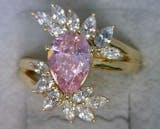Sorry, but in most cases “grandma’s jewelry organizer” where everything is jumbled together is a BIG NO-NO.
Jewelry is made of many materials and many of those materials will SCRATCH EACH OTHER AT THE SLIGHTEST TOUCH.
For example, a diamond will scratch a sapphire, ruby, emerald, or cubic zirconia stone (plus almost any other mineral on the planet). A sapphire, ruby, emerald or cubic zirconia stone (plus many other natural and synthetic gemstones) can scratch platinum. Steel, palladium, cobalt, tungsten, or titanium will also scratch platinum. Platinum or palladium will scratch gold, silver, or copper.
The phenomenon of what materials scratch other materials is explained by a scientific principle called “The Mohs Scale” (source: Wikipedia). We talk a bit more about this concept in a blog post: Moh's scale of Hardness, and How to Protect your Jewelry from unwanted Scratches.

If you just want to skip to the conclusion...because of the Moh’s scale of what scratches what and other reasons, we recommend storing each jewelry item in separate felt-lined or leather-lined box or felt/velvet/cloth bag to prevent jewelry items from hitting each other or rubbing against each other and possibly causing scratches and chips.
Today we'd like to continue our discussion from that blog posted a couple days ago, but now assuming you know a bit about the Moh's scale of hardness and what causes scratches to jewelry...that it's a bad idea to store jewelry in a jumble where individual pieces of ANY KIND can touch each other...we can move on to more specific advice for storing and keeping your fine cubic zirconia jewelry safely...and how specifically to store and keep rings, necklaces, pendants and earrings.
First, always store your jewelry in a cool, dry place.
Second, store your jewelry pieces individually.
Third, a few general tips on HOW TO PREVENT SCRATCHES IN THE JEWELRY BOX.
Diamond (10.0 Moh's scale, highest) scratches everything else, and that’s why you shouldn’t store diamonds in the same jewelry box where they can touch other genuine or imitation stone jewelry (it’ll scratch jewelry made with every other common material, including cubic zirconia and all real and artificial gemstones, not to mention gold, silver, or platinum).
You read that right! It’s not safe to store diamonds alongside anything else, as it will scratch everything else you have in your jewelry box when they touch.
Did you know that even though diamonds are the hardest minerals, they can still be scratched? What could possibly scratch a diamond? Another diamond!

The same goes for Cubic Zirconia: only an object harder than a cubic zirconia can scratch a CZ (and there aren’t many of these), but it can also scratch itself if two pieces of cubic zirconia jewelry are jumbled together in a jewelry box.
One of the reasons we tried to make these two articles about the Moh's scale of hardness interesting is to take a boring topic and give you a reason to read it.
We hope the result helps our customers to prevent scratches to your jewelry-- whether it be diamond, cubic zirconia, sapphire, emerald, ruby, gold, silver, palladium, platinum or other-- by being aware of the other objects that you/your jewelry may come into contact with in a given day and over a lifetime of wear and storage.
We recommend that when you put your CubicZirconia.com jewelry in your jewelry box, AT MINIMUM you separate each cubic zirconia piece of jewelry from these kinds of jewelry: Diamond, Cubic Zirconia, Alexandrite, Cat's Eye, Chrysoberyl, Ruby, Sapphire, Tungsten Carbide, and watches.
In a perfect world, it wouldn't be just your cubic zirconia jewelry you protect!

You just wouldn't jumble your jewelry pieces made of ANYTHING in a drawer or jewelry case where they can easily scratch one another.
Lastly, here are some jewelry-type-specific pieces of advice:
For rings, make sure each ring is secure in an individual felt/leather-lined box or felt/velvet/cloth bag to prevent the rings from not only scratching but also rolling around, potentially damaging their prongs and possibly causing stones to loosen in their settings.
For necklaces, storing them separate from each other and from other jewelry items will help fight scratching and also prevent them from getting tangled. When storing necklaces, be careful not to “fold” them so that the stones and metal from one part of the necklace are lying on top of the stones/metal of another part of the necklace. Necklace bags made of felt/velvet/cloth are good for this, just lay them out flat! We also recommend you re-clasp your necklace after taking it off.
For earrings, make sure to attach the earring backs after taking off your earrings so as not to lose them and also to make sure you’re using the back that was originally designed for your earring. We recommend you keep your earrings in flap boxes not only to prevent scratching but also to keep them from rolling loose and possibly damaging their settings and/or causing stones to loosen in their settings.
Keep those tips in mind and use them...and your jewelry both purchased from CubicZirconia.com and from wherever else you have purchased or been gifted jewelry will last longer and look better for years to come!














